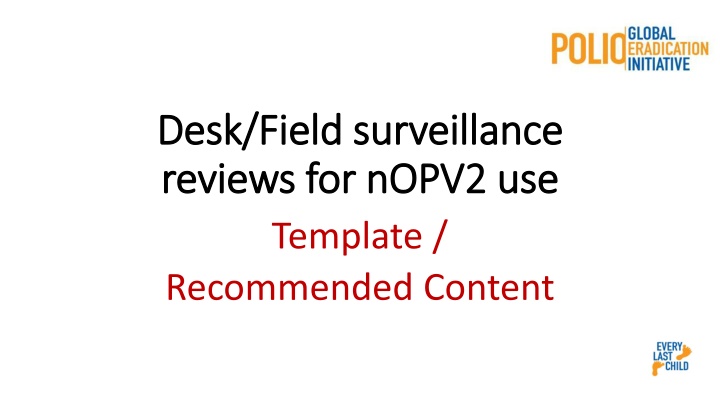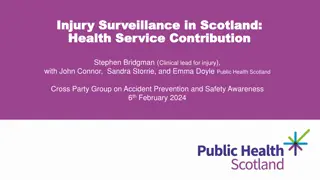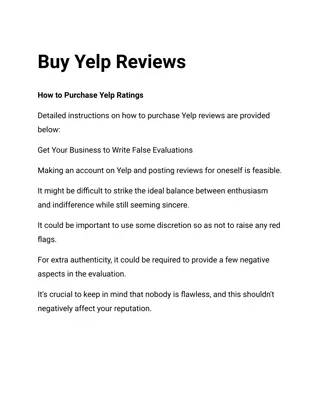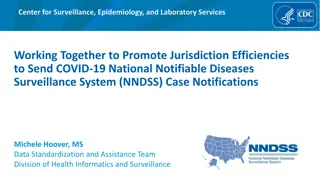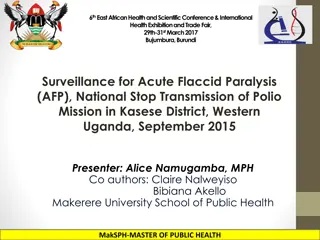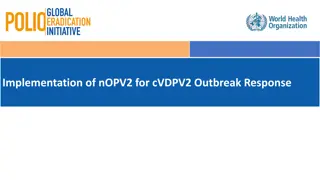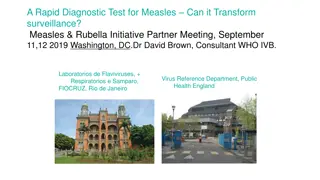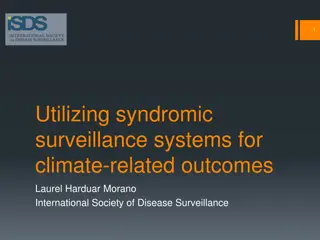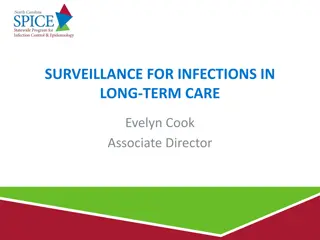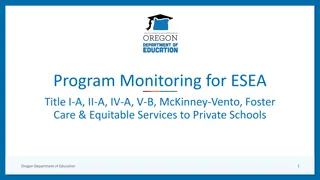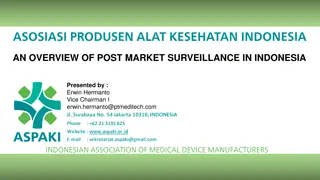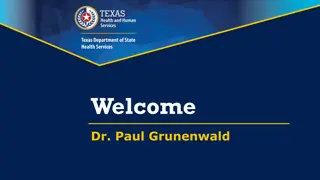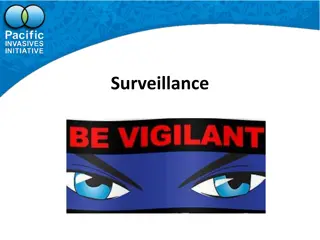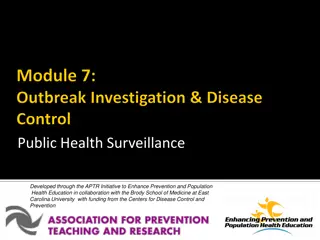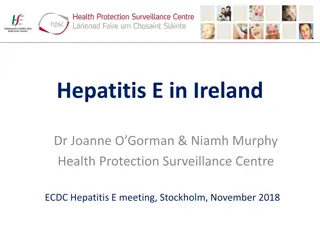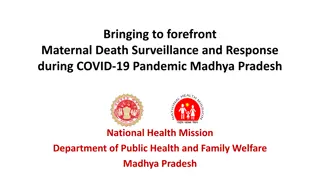Standardizing Desk Surveillance Reviews for nOPV2 Use
This document template offers standardization in format and content of desk surveillance reviews for facilitating comparisons across countries and regions. It aims to guide data managers and review team members in conducting desk reviews tailored to specific needs and contexts. The template is divided into core and additional analyses sections, with suggested sections covering various aspects of surveillance data analysis. Limitations exist, emphasizing the importance of original data accuracy and completeness.
Download Presentation

Please find below an Image/Link to download the presentation.
The content on the website is provided AS IS for your information and personal use only. It may not be sold, licensed, or shared on other websites without obtaining consent from the author.If you encounter any issues during the download, it is possible that the publisher has removed the file from their server.
You are allowed to download the files provided on this website for personal or commercial use, subject to the condition that they are used lawfully. All files are the property of their respective owners.
The content on the website is provided AS IS for your information and personal use only. It may not be sold, licensed, or shared on other websites without obtaining consent from the author.
E N D
Presentation Transcript
Desk/Field surveillance Desk/Field surveillance reviews for nOPV2 use reviews for nOPV2 use Template / Recommended Content
1. Introduction 1. Introduction Purpose of this document This template aims to offer some standardization in the format and content of desk surveillance reviews to facilitate comparisons across Countries and Regions. It also aims to streamline the process of conducting some of the analyses by proposing automations. Audience This template aims to guide data managers and review team members. Use This template acts as a guide in conducting desk reviews and is meant to be adapted to - the activity that the review supports, i.e. the immediate needs of the Region and/or Country (e.g. short review targeting a specific issue vs. exhaustive review, part of an OBRA or a field surveillance review), and - the context (e.g. variables may vary according to the regional databases) Limitations Interpretations derived from the findings ultimately depend on the accuracy and completeness of the original data.
2. Content 2. Content explanations This desk review template is divided into 2 Parts: Core analyses ( Core content ) Additional analyses ( Additional content ) Both Parts are divided into suggested Sections articulated as follows: 1 slide with suggested analyses and presentation, followed by 1 slide taken from existing reviews, inserted as illustrations or examples Notes: - The template does not give guidance on the number of analyses / slides to produce for each section. - Entries, in this slide set, followed by an [*] are the objects of Comments in the Notes section of the slide.
Table of contents Table of contents Core analyses ( Core content ) Section 1: Country profile Section 11: Final diagnosis Section 2: Confirmed cases and positive isolates Section 12: Source of notification of AFP cases Section 3: AFP cases Section 13: Active & Passive surveillance Section 4: NP AFP rate Section 14: Environmental surveillance Section 5: Stool adequacy Section 15: Supplementary surveillance Section 6: Stool condition Section 16: Laboratory (added for nOPV2) Section 7: Reverse cold chain Section 17: Impact of COVID19 (added for nOPV2) Section 8: Timelines Conclusion Section 9: Contact sampling Section 10: 60-day follow up Additional analyses ( Additional content ) Section 18: Humanitarian updates Section 19: Social profile
3. Source of data 3. Source of data The sources of data used for these analyses include, but are not limited to: - AFP line listing - Contact line listing (if available) - Lab line listing - SIA database (incl. SIA results) [some of which is also available through POLIS] - Online resources from e.g. other UN agencies, NGOs and Universities - ODK data AVADAR, eSURV, ISS, AFP (incl. with geo-coordinates) - AFR, EMR, Other (e.g. for population figures, shapefiles, .) Notes: 1) For each desk review, the source of the data used for the analyses should be listed. 2) Notes re. data inconsistencies found in the data sources should be included, either as footnotes or in separate slide.
4. Recommendations 4. Recommendations Below are cross-sectional recommendations: Comparisons across admin levels Some indicators can benefit from being put into perspective by comparison the admin level under study with the admin level above, e.g. Country vs. Region; District/Admin 2 vs. Province/Admin 1 E.g. NP AFP rate, OPV/IPV status Age breakdown The following breakdown is generally used (in months): 0-5; 6-59; 60-144; 145-179; 179 Unknown OPV/IPV status may be analyzed separately if significant Recommendations from previous desk reviews and meetings* Some reviews may benefit from comparing the findings to recommendations made in previous reviews or during previous meetings. Interpretation* It is sometimes helpful to add a short, preliminary/tentative interpretation of the results of an analysis one has made, to point to an inconsistency, and/to raise a question,
Section 1: Country profile Country profile Purpose: Presentation: Content: Country details 1. Country details: - Population density - Population figures - Location of ES sites (if applicable) Map* with - Admin 1 and/or Admin 2 divisions - Population density at Admin 1 and/or Admin 2 Table / List of Admin 1 with pop<15 figures (if available and helpful, pop<5 as well) Table with # of Admin 2 by pop <15 size Background info
Section 2: Confirmed PV isolates by source Confirmed PV isolates by source (WPV / cVDPV / VDPV / iVDPV) Presentation: Content: Purpose: Confirmed poliovirus isolates (WPV / cVDPV / VDPV / iVDPV) by source 1. In AFP - incl SIAs 2. In ES - incl SIAs 3. In Other source, e.g. PID patient; the community. Narrative with details of outbreak(s)* Dendrogram (snapshot) Epi curve: - By week, month, year, over >2 years (depending) - With SIAs Map: - By year or jointly - Cases/Positive isolates, with pop density Background information on situation and risk
Section 3: AFP cases AFP cases Purpose: Presentation: Content: AFP cases 1. AFP case distribution 2. Silent districts 3. Compatible cases (incl. by findings at FU) and Potential compatible cases (i.e. not classified and rejected by ERC. Incl. breakdown by findings at FU)* 4. Hot cases* 5. Validation and Classification 6. % of AFP cases with verified geo- coordinates (if applic.) 7. Clusters (incl. found and investigated prior to review AND those found during the desk review) Bar graphs / Epi curves: - By Admin 0 and Admin 1 - By month, over 3 years - With SIAs Maps: - By year, over 3 years underlay maps with: - NP AFP rate - Pop density Narrative / Table (for potential compatible and hot cases) Identification of: - possible gaps in surveillance / areas poorly covered by the system - missed clusters (time & space)* - areas poorly covered by SIAs and/or RI ( hot cases) - possible over-discarding by expert group, of cases that could have been polio compatible % AFP cases validated Breakdown of final classification
Section 4: NP AFP rate NP AFP rate Purpose: Presentation: Content: Surveillance indicators: NP AFP rate 1. At Admin 0 (with stool adequacy, pending, confirmed cases as a summary table) 2. At Admin 1 3. At Admin 2 4. NP AFP rate with selected diagnoses (e.g. GBS, TM, TN, NPEV)* 1. 2. - - - - Admin 0: Table, over >5 years Admin 1 and/or Admin 2: Map Calendar year Rolling 12 and/or 6 months Av rate over 3 years Table: Comparison over 2 years and/or over same period Table / XY Chart: Comparison of rates and accessibility Identification of: - possible gaps in surveillance / areas poorly covered by the system - possible anomalies ( over-reporting ) quality of validation? -
Section 5: Stool adequacy Stool adequacy Purpose: Presentation: Content: Surveillance indicators: Stool adequacy 1. At Admin 0 and Admin 1 - Comparison over time 2. At Admin 2 - Mapping of inadequate cases - incl. those with no follow up (incl. died / lost to FU) and discarded Table or map - Comparison of indicator over 2 years and/or over same period, current and previous year(s) Map - Admin 1 & 2, all AFP cases, highlighting those with inadequate stool specs - Admin 1 & 2, all AFP cases with inadequate specs + no follow up + discarded Identification of: - possible gaps in surveillance (incl. gaps in knowledge) - possible issues with transport and/or reverse cold chain - Possible issues with over-discarding by expert group
Section 7: Stool condition Stool condition Purpose: Presentation: Content: Stool condition 1. Stool condition and transport (timeliness) Identification of possible issues from collection to arrival at the lab (incl. batch sampling) Comparison with stool adequacy Data quality check (AFP line listing and Lab database entries) Table: - Comparison over 2 years Narrative
Section 8: Reverse cold chain Reverse cold chain Purpose: Presentation: Content: Reverse cold chain & Lab performance 1. NPENT isolation - The rate needs to be put in perspective, e.g. compared to previous years for a change in trend 2. Sabin isolation, incl. SL2 isolation NPENT: indicator of quality / integrity of the reverse cold chain (timeliness & performance of transport? compare with other countries?) Sabin: indicator of how well the lab can perform isolation of polioviruses. With analysis of NPENT, it gives info on reverse cold chain If SL 2 isolation, check if an investigation was done Bar chart (NPENT rate) - By Admin 0, over 2-3 years - By Admin 1, comparing current & previous year(s) Table (Sabin)* - By Admin 0 - By Year and Month - With SIAs Maps (SL; NPEV) - Admin 1, current and previous year Narrative - Indicate discrepancies (if any) btw entries in lab and AFP LL
Section 9: Timelines Timelines Purpose: Presentation: Content: Timelines 1. Surveillance and lab timelines Bar graph: Identification of possible issues at various steps in the process - By Admin 0 and Admin 1 - Av. number of days - Comparison over 2 years Table - By Admin 0 and Admin 1 - With min, max, median (and/or average) number of days
Section 10: Contact sampling Contact sampling Purpose: Presentation: Content: Contact sampling 1. AFP and Contact sampling* (and Community / Other sampling) Bar chart: - By Admin 0 or Admin 1 - By week and month of onset (AFP) & date of collection (Contacts), over 2(-3) years - By eligible cases, over 2(-3) years Narrative: - Number of contacts / inadequate AFP case - Main reasons for taking contact samples - Compare number of Contacts in AFP/Contact and Lab line lists Check whether contact sampling of inadequate cases is systematically done Find out main reasons for taking contact samples Identify possible discrepancies btw AFP and Lab line listings % of cases eligible for contact sampling who have effectively benefitted from contact sampling (EMRO)
Section 11: 60 60- -day follow up day follow up Purpose: Presentation: Content: 60-day follow-up 1. 60-day follow up of inadequate AFP cases 2. Non polio AFP cases with residual weakness Check whether 60-day follow up visits of inadequate AFP cases is systematically done Check whether they are classified and what classification they received Check timeframe (% <60 days? % >90days) % NP AFP cases with residual weakness Table: - By Admin 0 - Comparison over 2(-3) years Narrative
Section 13: Final diagnosis Final diagnosis Purpose: Presentation: Content: Final diagnosis 1. Percentage of Non polio AFP cases with final diagnosis. 2. Distribution of Non Polio AFP cases by type of final diagnosis Graph/Table - By Admin 0 - Over 2-3 years Narrative - Check whether Non polio AFP cases have a final diagnosis Check trend of differential diagnosis
Section 14: Source of notification of AFP cases Source of notification of AFP cases Purpose: Presentation: Content: Source of notification of AFP cases 1. Answer the question: who notified the cases? (CHW, volunteers, health workers, NGOs, ), and: - Break down for inadequate cases to differentiate key reasons for late notification - Check if country has targeted shortcomings 2. Notification of AFP cases through AVADAR: - % out of the total - % suspected investigated out of those suspected reported - % true alerts ( true AFP ) out of those investigated Pie chart: - Admin 0 - Comparison over 2 years Graph: - By type of person who notified (incl. SIA / vaccination team) - By adequate / inadequate specimens Map: - Admin 1 or 2 - 1- or 2-year display - Areas covered by AVADAR (Admin 1, Admin 2) Gauge level at which AFP cases are reported, and thus: - May lead to questions such as: missed opportunities ? missed cases ? - May point to gaps in reporting, incl. review of surveillance network and/or training needs.
Section 15: Active & Passive Surveillance Active & Passive Surveillance Presentation: Content: Active & Passive Surveillance ( zero reporting ) - esp. if in-country review 1. Key indicators of: - Active surveillance: - Completeness - Coverage / Representativeness? - Realistic number of sites (high, medium & low priority) - Prioritization of sites (Was it correctly done? Does it make sense?) - Revision (When was it revised last?) - Passive surveillance: - Timeliness - Completeness of weekly zero reporting Purpose: To gauge extent to which active surveillance visits are made esp. against the calendar of visits & coverage of network & whether the nb of sites is realistic & priotization is correct To assess the extent to which timeliness and completeness are monitored for zero reporting Map: - Location of health facilities* - Location of reporting sites* - Location of visits & # of visits* - Inaccessible areas* Comparison of reports (site visit reports, zero-reports ) with eSurv/ISS data (completeness)
Section 16: Environmental surveillance Environmental surveillance Purpose: Presentation: Content: Environmental surveillance (ES) 1. Isolation from ES, incl. site- specific indicators: - ( 80) % of scheduled samples are collected (at least one sample per month per site) - ( 80) % of samples are collected on the date assigned / at assigned time of day* - ( 80) % samples arrive in the lab** within 3 days of collection (in country) or 7 days (international shipment) - ( 80) % of samples arrive in the lab in good condition - EV are isolated in 50 % of samples Table: - By site (incl. add photo & coordinates, if available) - Rolling 6-month comparisons - Comparison over 2-3 years Map: - Location of sites - Location of key isolates ( positives ) Country dashboard*** Country-specific: In the absence of confirmed polio cases, this can provide insight into potential outbreak in humans Towards tail end of an outbreak, this provides a sense of the intensity and spread of ongoing virus transmission
Section 18: Supplementary surveillance Supplementary surveillance Presentation: Content: Purpose: Supplementary surveillance (for high-risk / hard-to-reach areas) 1. Surveillance activities to improve reach and coverage for high-risk and/or hard-to-reach areas and communities, e.g.: - Community sampling - Ad hoc case search - Ad hoc environmental surveillance - Community-based surveillance (e.g. targeting nomads, IDPs, ) Maps: - Admin 1 and 2 with: - hard-to-reach areas/communities - Ad hoc surveillance activities (e.g. Transit vaccination teams) Narrative: - Description of activities Graphs (if data is available): - Data that show impact (e.g. % of AFP reported by source before & after introduction of CBS) Country-specific: Describe activities that have been introduced to strengthen surveillance and access and cover high- risk and/or hard-to- reach areas and communities, incl. through one, or a mix of, supplementary surveillance activities
Section: Laboratory Section: Laboratory Yes No Does the laboratory have capacity for virus isolation, ITD (intratypic differentiation) and environmental surveillance: laboratory space, staff, supplies, training? Has the laboratory sufficient resources to face 100% increase in workload? Is the laboratory fully accredited by WHO for these activities? What were the most recent scores in WHO annual accreditation reviews? Is the laboratory familiar with changes in the environmental surveillance virus isolation algorithm required for nOPV2 detection?* Are laboratory technicians trained on the new nOPV2 ITD assays (running, interpretation and troubleshooting)? Has the laboratory received and validated new sets of primers (in addition to ITD kits) for nOPV2 detection? Has the laboratory faced shortage of ITD reagents or consumables during the last six months? Does the laboratory have a regularly maintained PCR machine?
Section: Laboratory (2) Section: Laboratory (2) Yes No Does the laboratory has mechanism of reporting results to CO and WHO? Does the laboratory have a polio nucleotide sequencing capacity? Is the laboratory fully accredited for sequencing by WHO? Has the laboratory capacity for increase in sequencing workload? Has the laboratory capacity for whole-genome sequencing of PV2 L20B isolates? If no sequencing capacity, does the laboratory have a mechanism for referring L20B-positive samples to a WHO-accredited laboratory for VP1 sequencing? Has the referral laboratory capacity for increase in sequencing workload? Has the referral laboratory capacity for whole-genome sequencing of PV2 L20B isolates? If the referral laboratory has no capacity for whole-genome sequencing, is there a mechanism for referring PV2 L20B isolates to a WHO Global Specialized Laboratory for whole-genome sequencing?
Section: Impact of COVID Section: Impact of COVID Content: Trend in AFP case detection since COVID19 started Storage of specimen shipment/logistic of transport to the lab/Timeliness Trend in Active surveillance visits since COVID19 started Highlight any measures that may negatively impact the surveillance system (HR, logistics, confinement, ) Purpose: Presentation: Maps and Graph from COVID flags in POLIS (https://extranet.who.int/ polis/Account/Login?retur nUrl=%2Fpolis%2FHelp) Country-specific: Describe how COVID19 may have affected some key components of the polio surveillance system
Section: Conclusions Conclusions Purpose: Presentation: Content: Conclusions 1. Conclusions focusing on overall sensitivity of the surveillance system 2. Conclusions on gaps to address before nOPV2 use (see list of criteria in Phase B, readiness tool) Table / Matrix Drawing conclusions from the key findings and deriving the main risks
Section 21: Humanitarian updates Humanitarian updates Purpose: Presentation: Content: Humanitarian updates 1. Humanitarian updates, including: - Refugee and/or IDP movements, location and numbers - Results of nutrition surveys - Location of humanitarian actors - Financing gaps 2. Security update (warrants a separate slide in certain cases) Snapshots of maps, charts, other from referenced humanitarian actors, such as: - UNCHR - IOM - OCHA - ECHO Found under their sites (e.g. OCHA s ReliefWeb and HDX) Provide a backdrop to context, incl. risks
Section 22: Social profile Social profile Purpose: Presentation: Content: Social profile 1. Special populations, e.g. hard-to-reach* (due to geography or insecurity) and nomads 2. Additional information re. population movement of significance (e.g. IDP, refugee) that may affect analyses Maps (incl. of nomadic group settlements, movement patterns if available) Check if: - Numbers affect NP AFP rates - Hard-to-reach status affects stool adequacy and condition Tables
